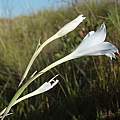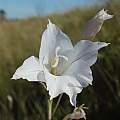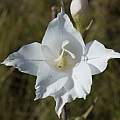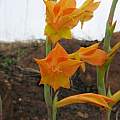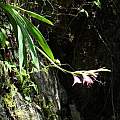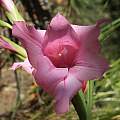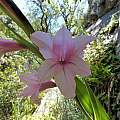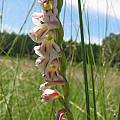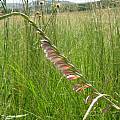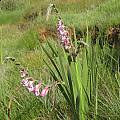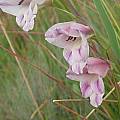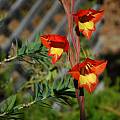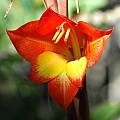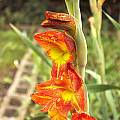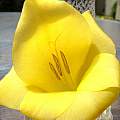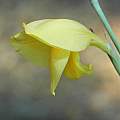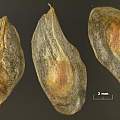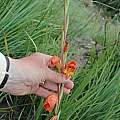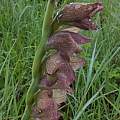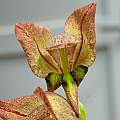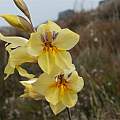Summer rain Gladiolus are mostly from the eastern part of South Africa. They generally like their summers wet and their winters dry, but just exactly how wet and how dry may vary widely depending on on the exact location of origin. Among the summer rain species are some of the most frost hardy of the African species, but as most tropical African Gladiolus follow a summer rain pattern as well, some are quite frost tender.
Page 2: G. densiflorus... Page 3: G. inandensis... Page 4: G. mortonius... Page 5: G. rehmannii... Page 6: G. sericeovillosus...
Gladiolus albens Goldblatt & J.C.Manning, syn. Gladiolus maculatus Sweet ssp. eburneus Oberm., is a narrow endemic of the Eastern Cape where it is found on grassy slopes and in fynbos type vegetation on light well drained soils. Although it grows primarily in a summer rainfall zone, the area where it grows does get some winter rainfall and this species flowers in the fall in April and May and has its main growth in winter after flowering. Plants are generally 25 to 50 cm high and the flowering spike has 1 to 3, rarely to 5, flowers. Flowers are white to cream, sometimes with faint speckles or streaks in the throat or all over the tepals, with a long slender perianth tube (35-50 mm) that expands in the upper part and have a dusty sweet scent. Photos taken by Rachel Saunders in the Eastern Cape.
Gladiolus antholyzoides Baker is distributed across the central and eastern high veld of South Africa. Flowers are yellow, sometimes streaked with red or orange and with an orange ring around the throat. This species was once included in Antholyza as Antholyza laxiflora and Antholyza schlechteri, presumably because of its long perianth tube. It has also had other Gladiolus species names.
Gladiolus appendiculatus G.J.Lewis is native to the Northern Provinces, South Africa and Swaziland where it grows in grassland on mountain slopes usually above 1800 m up to 2100 m. Growing from 35 to 60 cm, it has softly leathery 6 to 9 long leaves tapering to a sharp or blunt tip and 6 to 14 white to pink unscented flowers marked mauve or pink in the lower tepals, borne on one side. The tepals are unequal in size with the upper three largest and the dorsal arching over the stamens. Anthers have long tails. Flowering occurs in April and May. Photo from Rachel Saunders.
Gladiolus aurantiacus Klatt is found in the summer rainfall area often growing in high grassland and is centered in KwaZulu-Natal extending into Mpumalanga and Swaziland. Growing from 45 to 75 cm high, it has stem leaves with short blades and foliage leaves with longer blades that are produced on separate shoots near the end of flowering. The unscented flowers are yellow, dotted or streaked with red or orange which gives them the appearance of being orange borne on a 10 to 16 flowered erect spike. Flowers have an elongate flower tube, slender in the lower half. The dorsal tepal is slightly ascending to horizontal and the lower tepals with yellow blotches in the lower half curve sharply downward. Flowers are adapted for pollination by sunbirds. Flowering is unusual as it occurs early, mostly in September and October, before the main rainy season has started. Photo from Rachel Saunders.
Gladiolus cataractarum is a rare endemic of the southern African summer rainfall region. Plants grow on cliffs and steep rocky slopes on quartzite in sheltered, south facing sites. Growing to 70 cm high, this species has eight to nine lanceolate leaves of different sizes and pink unscented flowers with the lower three tepals marked with reddish longitudinal lines. The first photo of the plant in habitat taken by Rod Saunders. Flower photos from Rachel Saunders. They had to walk up a gully to reach it and found it difficult to photograph hanging off the cliff.
Gladiolus crassifolius Baker (syn. G. rachidiflorus, G. thomsonii, G. masukuensis, G. mosambicensis, G. tritoniiformis, G. junodii, G. coranthii, G. gazensis, G. dieterlenii) is a widespread species of eastern southern Africa. It is found also in tropical Africa. Plants in southern Africa usually grow in hilly country in well-drained rocky grassland habitats and bloom late summer. Plants in tropical Africa bloom earlier before the new season’s leaves have developed. Flowers are borne in a 16 to 22 flowered spike and are usually pale to deep pink or light purple. The lower lateral tepals have a dark band of color across the lower half of the limbs. Photos taken by Cameron McMaster at Maclear and Sentinel Peak in the Eastern Cape in 2008.
Gladiolus dalenii Van Geel is a widespread and common species found not only in Southern Africa, but also in other parts of tropical Africa. It has been known by a number of names over the years; there have been 27 synonyms for the tropical Africa and Madagascar forms and 14 more for the southern African forms. The main synonyms for the southern Africa collections have been Gladiolus natalensis and Gladiolus psittacinus. This species blooms at different times of the year depending on the location, but there are probably flowers every month of the year somewhere in its native habitats. Flowers are either red to orange with yellow markings on the lower half of the three lower tepals or yellow to greenish with red to brown streaks on the upper tepals. Although it favors moist habitats and is often found in grassland, it can also be found in dry habitats with only a short wet season. The ones I grew in Northern California lived for a number of years in the garden, dormant during our wet winters, appearing late spring and surviving through the dry summer and blooming in the fall. The flowering stalks were very tall with a number of flowers. Photos 1-2 of those plants were taken by Mary Sue Ittner. Photo 3 by Cameron McMaster shows plants in cultivation. Photos 4-5 by Mary Hunter and Mary Sue Ittner show the first bloom from seed of a yellow form of ssp. dalenii, once known as Gladiolus primulinus blooming in late summer in Northern California. The last photo by David Pilling shows seed.
The first photo below from Cameron McMaster shows flowering plants in habitat in the Eastern Cape. The second is another habitat shot taken near Balloch in the Eastern Cape, January 2010 by Bob Rutemoeller. Photo Nr. 3 from Rachel Saunders shows an unusual color form and was taken in northern KwaZulu-Natal in January 2015. The last photo shows the beautiful detail on likely the same color form, as the seeds were obtained from Silverhill, flowering the second year from seed for Martin Bohnet.
Gladiolus delpierrei Goldblatt grows on marshy sandstone slopes at 1200 m in the Cederberg Mountains. Growing from 40-45 cm high and blooming December to January, it has yellowish cream flowers with yellow and red marking on the lower tepals. Photo taken January 2014 by Rachel Saunders.
Page 2: G. densiflorus... Page 3: G. inandensis... Page 4: G. mortonius... Page 5: G. rehmannii... Page 6: G. sericeovillosus...
